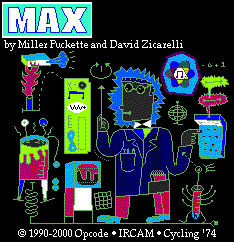This text was written in the year 2000, and reflects the stage of my work at the time.
”I use MAX ever since it was commercially available in 1990. As a graduate student at UC Berkeley’s Center for New Music and Audio Technology I was around when the the guys from Opcode were introduced to David Zicarelli‘s version of MAX (2.0). But that’s history now.
show moreDavid Wessel initiated me to MAX in his Music 158 class (and freed me from my habit to use BASIC for music programming). In October 1990, I wrote my first patch for a concert by the Ensemble Modern that featured my piece Klangmoraste. Coincidentally, Les Stuck was the tech guy who made sure that things were running smoothly.
The following two years I served as the graduate student instructor to David’s class while working on numerous projects employing MAX, particularly for my microtonal compositions Heptadecatonic Drops and Two Cartoons. Being the assistant at CNMAT, I had become an experienced debugger and it came as no surprise that David – on behalf of Opcode – had me go over to Todd Rundgren‘s house in Sausalito when he got stuck with a huge MAX project that he was preparing for a concert in Japan. This little endeavor earned me my personal copy of MAX.
Fueled by the analysis/resynthesis work that was done at CNMAT, I started the research that eventually led to my opera Der Sprung. Der Sprung was derived from the analysis of a short text sample done on a SGI Indigo computer. I transferred the data from the SGI to the Macintosh platform and wrote dozens of MAX patches for many different purposes such as the display of the (spectral) data in musical notation both in MAX and FInale.
In the early 90’s neural networks became very popular, and Mike Lee (who had taken the same Music 158 class) wrote the neural network simulation for MAX that was later called mlp (multi-layer perceptron). David, once again, got me hooked and some of the best parts of Der Sprung were written employing a whole battery of mlp objects.
I also wrote several other MAX applications using neural nets such as an interactive texture space patch that implemented David Huron‘s concept of texture space and a key space patch spurred by David Wessel’s interest in Carol Krumhansl‘s fascinating research in tonal hierachies.
In 1995 after doing some MAX programming for Alvin Curran and UC Berkeley professor Cindy Cox, I started working on the interactive patch for Intermezzo – the psychological climax of Der Sprung. Intermezzo requires a 10-channel sound systems with 8 channels being routed to a choir of soloists wearing headphones. Its harmonic and temporal structure was derived from the noise of a recorded long-distance telephone call. I used a timeline object to control the eight choral plus three instrumental simultaneous layers of real-time composition and improvisation. The development of this patch took more than a year, and it is certainly the most complex programming work I’ve done until recently.
After moving back to Germany in September 1995, I spent most time finishing Der Sprung and reworking the real-time controls of some of my previous pieces such as SLEEPLESSNESS for flute(s) and live electronics. I also taught a MAX class at the Landesakademie NRW which was received very favorably.
In 1997, MSP was finally released and opened up a new realm of MAX programming. After my “stage” at IRCAM in 1993 I was fascinated by the possibilties of the ISPW‘s real-time signal processing capabilities and started hearing rumors that something similar was going to be available for the Macintosh platform. I was thrilled to learn that I could do the same neat things now on my Mac with hardly any extra costs.
Out of my work with MSP grew a new version of the Intermezzo interactor, the additive synthesis and MIDIfication patch Macaque (which uses a lot of the work I did for my opera) and, most recently, my project Quintet.net – a quintet on the Internet – which relies heavily on Adrian Freed‘s and Matt Wright‘s udp and OpenSoundControl objects.
In 1996, I co-founded the Ensemble WireWorks for interactive computer music with acoustic instruments and voices. I also work with pianist Jennifer Hymer, on performances for piano and live electronics. We have performed a number of compositions that employ MAX/MSP. Occasionally, the composers provide their patches themselves such as Steven Clark and Belinda Reynolds. In some cases, though, I had to reprogram the electronics from scratch, solely relying on the manuscript as in the case of Zwei Studien by German composer Dieter Schnebel.
Similarly, I turned the early Elektronische STUDIE II by Karlheinz Stockhausen into a patch with real-time sound synthesis and display of the graphical score, assisted by students of my Quantitative Music Theory class at the Münster Hochschule.”
show less
